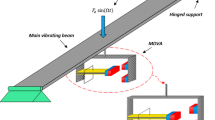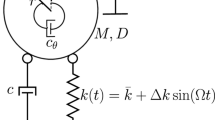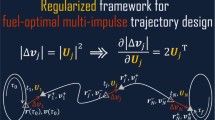Abstract
This paper proposed a unified energy-based control framework for fast, stable, and precision deployment of underactuated TSS. The tension controller with partial state feedback is derived from an artificial potential energy function and a dissipative function, where the control objectives and requirements are transformed into the necessary and sufficient conditions for these functions. The feedback law can be either linear or nonlinear, depending on the construction of the artificial potential energy function and the dissipative function. The controllability of the underactuated TSS is proved which is the original contribution of this work. The energy-based tension control is proved asymptotically stable by the Lyapunov technique and LaSalle’s invariance principle. Furthermore, the constraints on positive tension and nonnegative tether deploy velocity are incorporated into the energy-based tension controller by control gain optimization using optimal control. Four controllers are developed based on the proposed control framework to demonstrate the effectiveness and robustness of the proposed energy-based framework using numerical simulation.

















Similar content being viewed by others
References
Kumar, K.D.: Review on dynamics and control of nonelectrodynamic tethered satellite systems. J. Spacecr. Rockets 43(4), 705–720 (2006)
Zhong, R., Zhu, Z.H.: Libration dynamics and stability of electrodynamic tethers in satellite deorbit. Celest. Mech. Dyn. Astron. 116(3), 279–298 (2013)
Qi, R., Misra, A.K.: Dynamics of double-pyramid satellite formations interconnected by tethers and coulomb forces. J. Guid. Control Dyn. 39(6), 1265–1277 (2016)
Zhong, R., Zhu, Z.H.: Long-term libration dynamics and stability analysis of electrodynamic tethers in spacecraft deorbit. ASCE J. Aerosp. Eng. 27(5), 04014020 (2012)
Ma, Z., Sun, G.: Adaptive sliding mode control of tethered satellite deployment with input limitation. Acta Astronaut. 127, 67–75 (2016)
Kang, J., Zhu, Z.H., Wang, W., Li, A., Wang, C.: Fractional order sliding mode control for tethered satellite deployment with disturbances. Adv. Space Res. 59(1), 263–273 (2017)
Rupp, C.C.: A tether tension control law for tethered subsatellites deployed along local vertical. NASA TM X-64963, Marshall Space Flight Center, Huntsville, AL, USA (1975)
Fujii, H., Ishijima, S.: Mission function control for deployment and retrieval of a subsatellite. J. Guid. Control Dyn. 12(2), 243–247 (1989)
Vadali, S.R.: Feedback tether deployment and retrieval. J. Guid. Control Dyn. 14(2), 469–470 (1991)
Pradeep, S.: A new tension control law for deployment of tethered satellites. Mech. Res. Commun. 24(3), 247–254 (1997)
Sun, G., Zhu, Z.H.: Fractional-order tension control law for deployment of space tether system. J. Guid. Control Dyn. 37(6), 2062–2066 (2014)
Wang, C., Wang, P., Li, A., Guo, Y.: Deployment of tethered satellites in low-eccentricity orbits using adaptive sliding mode control. J. Aerosp. Eng. 30(6), 04017077 (2017)
Wen, H., Zhu, Z.H., Jin, D., Hu, H.: Space tether deployment control with explicit tension constraint and saturation function. J. Guid. Control Dyn. 39(4), 916–921 (2015)
Wen, H., Zhu, Z.H., Jin, D.P., Hu, H.Y.: Constrained tension control of a tethered space-tug system with only length measurement. Acta Astronaut. 119, 110–117 (2016)
Wen, H., Jin, D.P., Hu, H.Y.: Optimal feedback control of the deployment of a tethered subsatellite subject to perturbations. Nonlinear Dyn. 51(4), 501–514 (2008)
Williams, P.: Deployment/retrieval optimization for flexible tethered satellite systems. Nonlinear Dyn. 52(1–2), 159–179 (2008)
Steindl, A., Troger, H.: Optimal control of deployment of a tethered subsatellite. Nonlinear Dyn. 31(3), 257–274 (2003)
Wei, C., Luo, J., Gong, B., Wang, M., Yuan, J.: On novel adaptive saturated deployment control of tethered satellite system with guaranteed output tracking prescribed performance. Aerosp. Sci. Technol. 75, 58–73 (2018)
Liu, M., Zhan, X., Zhu, Z.H., Liu, B.: Space tether deployment with explicit non-overshooting length and positive velocity constraints. J. Guid. Control Dyn. 40(12), 3313–3318 (2017)
Khalil, H.K. (ed.): Nonlinear Systems, 3rd edn. Prentice-Hall, Upper Saddle River (2002)
Lorenzini, E.C., Bortolami, S.B.: Control and flight performance of tethered satellite small expendable deployment system-II. J. Guid. Control Dyn. 19(5), 1148–1156 (1996)
Beletsky, V.V., Levin, E.M.: Dynamics of Space Tether Systems, Advances in the Astronautical Sciences, vol. 83. American Astronautical Society, Springfield (1993)
Acknowledgements
This work is supported by the Discovery Grant (RGPIN-2018-05991) of the Natural Sciences and Engineering Research Council of Canada (NSERC) and the FAST Grant of Canadian Space Agency.
Author information
Authors and Affiliations
Corresponding author
Ethics declarations
Conflicts of interest
The authors declare no conflict of interest in this article.
Appendix: Stability analysis of two equilibrium states
Appendix: Stability analysis of two equilibrium states
A1. The horizontal equilibrium states \((y_1 ,y_2 ,y_3 ,y_4 ,y_5 ) =(c_1^h ,0,0,1,0)\) and \((y_1 ,y_2 ,y_3 ,y_4 ,y_5 )=(c_1^h ,0,0, -1,0)\) are unstable.
Proof
Assume there is any small perturbation of \(\varepsilon \ne 0\) on \(y_3 \). From Eq. (26), there exist \((y_1 ,y_2 ,y_3 ,y_4 ,y_5 )=(c_1^h ,0,\varepsilon ,\sqrt{1-\varepsilon ^{2}},0)\) and \(V_\varepsilon =-\frac{3}{2}(c_1^h )^{2}\varepsilon ^{2}+U_a (c_1^h )<U_a (c_1^h )\). Since V is non-increasing as shown in Eq. (27), its trajectory will move away from the equilibrium state \((y_1 ,y_2 ,y_3 ,y_4 ,y_5 )=(c_1^h ,0,0,1,0)\). Thus, this equilibrium state is unstable. Similar perturbation analysis can be preceded with the other equilibrium \((y_1 ,y_2 ,y_3 ,y_4 ,y_5 )=(c_1^h ,0,0,-1,0)\) with the same conclusion. \(\square \)
A2: The vertical equilibrium states \((y_1 ,y_2 ,y_3 ,y_4 ,y_5 ) =(c_1^v ,0,1,0,0)\) and \((y_1 ,y_2 ,y_3 ,y_4 ,y_5 )=(c_1^v ,0,-1,0,0)\) are stable.
Proof
Note that \({{\mathcal {U}}}\) represents the union of two vertical equilibriums set \({{\mathcal {U}}}_+ =\{y | y=(c_1^v ,0,1,0,0)\}\) and \(\mathcal{U}_- =\{y | y=(c_1^v ,0,-1,0,0)\}\), respectively. It follows that from Eq. (27) the Lyapunov function \(V=-\frac{3}{2}(c_1^v )^{2}y_3^2 +U_a (c_1^v )\) obviously has the minimums only and only if the \(y_3^2 =1\). Thus, the states in the neighborhood of \({{\mathcal {U}}}_+ \) will converge to \({{\mathcal {U}}}_+ \) . This implies the states in \({{\mathcal {U}}}\) are locally asymptotically stable. Similarly, the states in the neighborhood of \({{\mathcal {U}}}_- \) will converge to \({{\mathcal {U}}}_- \). \(\square \)
Rights and permissions
About this article
Cite this article
Kang, J., Zhu, Z.H. A unified energy-based control framework for tethered spacecraft deployment. Nonlinear Dyn 95, 1117–1131 (2019). https://doi.org/10.1007/s11071-018-4619-x
Received:
Accepted:
Published:
Issue Date:
DOI: https://doi.org/10.1007/s11071-018-4619-x




